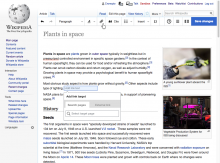The link input widget should have separate fields for the link target and the displayed text.
From various comments at T50789
There are essentially two ways to create a link:
[…]
#2 You click the link button first, enter the target and get out of the dialog, at which point the link text (identical to chosen link target) will be entered.
[…]
With this method, the user will often have to adjust the link's text afterwards, for instance in the case of plurals or if the target article is disambiguated with parentheses. But it is not clear to the user that adjusting the link text is safe and won't create a broken link; indeed the crucial distinction between link text and link target remains obscure. (Changing a singular to a plural is especially difficult since editing links at the end is not allowed.)I have checked the workflow of entering links in LibreOffice, Gmail and Word; they are all basically the same as in the Visual Editor, with two major differences:
a) the dialog popup window has a clear OK button, and [T54462]
b) the dialog popup window contains separate clearly labeled boxes for the link text and the link target.
I believe both of these changes make a lot of sense.
See Also: T52945




